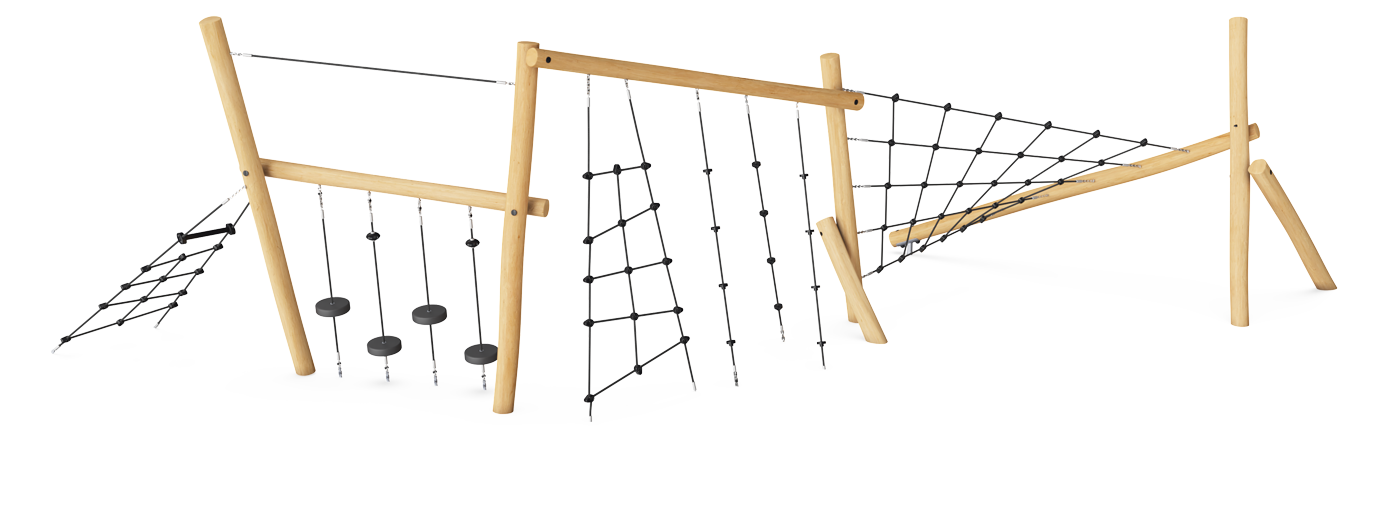
NRO854
Agility Trail 9
6+ Years
62.4 m2
12 Users

Nature play means interacting with nature: utilising elements like plants, trees, water, dirt, sand, and stones. This play usually takes place outdoors, allowing children to feel the breeze, breathe fresh air, experience changing weather, and enjoy the sun's warmth. Such play engages all the senses with sights, sounds, textures, scents, and even tastes, while also challenging children's physical movements in natural settings. Nature play equipment encourages outdoor free play, creating a social environment and developing essential social and collaborative skills.
Dr. Suzanne Quinn, Manager at the KOMPAN Play Institute on the benefits and essence of natural playgrounds.

A nature playground, as the name suggests, blends nature with play, allowing children to interact with natural elements and participate in diverse physical activities. These playgrounds promote social engagement and experiential learning. Key features include:
Dynamic movement and challenges: Uses natural materials such as tree stumps, wooden huts, and climbers to provide sensory experiences that enhance learning and spark imagination.
Integration of natural elements: Features non-toxic plants, trees, and structures for climbing, swinging, and balancing.
Open structures: Rope climbing frames and open designs give children a clear view of their surroundings, expanding their perception of the landscape.
Unlike traditional playgrounds, these spaces make free play a core part of the experience.

Why are becoming more popular? Unlike traditional playgrounds, nature playgrounds use elements like wood, stone, and plants to offer unique benefits for children. This article will examine how these nature-inspired spaces enhance child development.
Nature playgrounds, crafted from materials like wood and seamlessly integrated into the , provide a sensory-rich environment that supports physical, cognitive, and emotional growth in children. They allow children to move freely and creatively, exploring, running, jumping, climbing, crawling, touching, and smelling. These spaces encourage active play and creativity, leading to better fitness levels and the development of problem-solving skills through unstructured, imaginative play.
Additionally, promotes environmental awareness, teaching children the importance of caring for the environment while being accessible to children of all abilities.

Nature playgrounds offer a multitude of benefits that go beyond traditional play experiences. By incorporating natural elements, these playgrounds create a rich, sensory environment that fosters active and imaginative play, aiding in children's growth and learning. Nature-inspired playgrounds encourage creativity, open-ended play, and new forms of play in a safe, unstructured setting.
These playgrounds draw children and families outdoors, promoting prolonged and active play, which is vital for child development. Key benefits of natural playgrounds include:
Environmental Awareness: Acquaints children with the local ecosystem.
Emotional Development: Fosters appreciation and care for the natural world.
Cognitive Development: Reduces stress and enhances focus.
Physical Development: Supports active physical movements that aren't possible indoors.
Designing a nature playground involves careful to maximise the benefits these spaces offer to children. By integrating natural elements and focusing on diverse play values, designers can create environments that promote physical, cognitive, and emotional growth. Nature-inspired playground equipment allows children to engage with the natural world, learn about the environment, and develop an appreciation for nature.
Tips for Designing Nature Play Areas:
Create a Welcoming Atmosphere: Ensure the site is safe, with good sightlines, and is appealing and engaging for all visitors.
Engage the Senses: Include elements that can be touched, smelled, and seen.
Diverse Elements and Structures: Foster exploration and creativity by incorporating varied natural elements and play structures that provide challenges for different age groups and abilities.

Natural Materials
Opt for wooden materials, repurposed plastics, and natural ground coverings such as wood chips or sand to reduce environmental footprint and offer genuine sensory encounters.

Sensory Stimulation
Incorporate a variety of textures, scents, and sounds through elements like aromatic herb gardens, water features, and rustling leaves to engage all the senses.

Open Spaces
Ensure there are areas for free and unstructured play, allowing children to run, invent games, and interact socially in a flexible and dynamic environment.

Inclusivity & Accessibility
Design with accessibility in mind, using ramps, accessible play structures, and sensory-rich elements that cater to children of all abilities.

By focusing on these benefits and design principles, nature playgrounds can become vibrant, engaging spaces that support the holistic development of children while fostering a deep connection with the natural world. Nature inspired playgrounds promote motor skill development, sensory activities, creativity, learning about nature, and encourage children to engage with the natural environment through and elements inspired by nature.
The necessitates a considerate approach that takes into account the needs of all children and the incorporation of the environment. By choosing a cohesive theme, such as a fairy garden or a dinosaur-themed playground, designers can create an engaging and immersive play experience.
The selection of materials is also crucial, as it impacts the playground’s safety, durability, and maintenance.
By favoring natural elements like timber, recycled play equipment, boulders, logs, and the like, over synthetic materials, can minimise their environmental footprint while creating safe and durable spaces for play. These natural components not only add aesthetic charm but also provide children with sensory-rich experiences.
Furthermore, the use of natural materials like engineered wood fibre for playground surfacing ensures safety and inclusivity, making the playground accessible to children with disabilities. This meticulous attention to material selection is what sets natural playgrounds apart, offering a play experience that is both more eco-friendly and inclusive.
Nature playgrounds aren't just visually captivating; they offer a sensory feast for young minds. Incorporating diverse textures, shapes, and materials from nature, these play spaces provide a rich tapestry of sensory experiences crucial for cognitive growth. Natural play environments foster creativity, social interaction, and physical activities by integrating elements and textures from the great outdoors, offering opportunities for unstructured play and promoting inclusivity for children of all abilities. As they touch, feel, and interact with various natural objects, from smooth pebbles to rough bark, children engage in a holistic learning process, enhancing their sensory awareness and fine motor skills.
The addition of sensory gardens brimming with fragrant herbs, rustling foliage, and vibrant blooms adds layers of sensory stimulation, inviting children to smell, touch, and even taste the natural world. This multisensory approach to play helps children forge deeper connections with their environment, enriching their play experiences and supporting their overall development.
The inclusion of open spaces is an indispensable element in the design of a nature playground. These areas enable children to move freely and creatively within the environment, allowing them to explore, run, jump, climb, crawl, touch, smell, and engage in various activities. Open spaces are crucial for fostering unstructured and free play, which is vital for children's development of creativity and social skills. They provide children with the freedom to run, invent games, and interact with their peers in a relaxed and unbounded setting.
Furthermore, open spaces within nature play areas can be transformed by children's imaginations into anything from a bustling cityscape to an alien world. By incorporating and other elements, can encourage children to develop through challenging yet enjoyable activities. This flexibility in play options is one of the key advantages of natural playgrounds, as it allows children to express themselves freely and enhance their problem-solving abilities.
When curating and elements designed to captivate young minds for years to come, our offerings stand out. Renowned for our and innovative designs, our playgrounds foster the physical, cognitive, creative, and social/emotional development of children. Our commitment to using recycled materials also underscores our dedication to being more environmental responsible.
Our playgrounds cater not only to children but also to teenagers and adults, promoting recreation for all ages. The versatility of our offerings, from that ignite the imagination to solutions that welcome users of all abilities, makes us a premier choice for communities seeking to create engaging and enduring play spaces.

Jeanette Fich Jespersen

Suzanne Quinn

Maria Ross Larsen
University of Tennessee at Knoxville. "Natural playgrounds more beneficial to children, inspire more play, study finds." ScienceDaily. ScienceDaily, 11 October 2012. <>.
University of British Columbia. "Spending time in nature promotes early childhood development." ScienceDaily. ScienceDaily, 21 October 2021. <>.
Luchs, Annika, and Maren Fikus. "Differently Designed Playgrounds and Preschooler’s Physical Activity Play." Early Child Development and Care, vol. 188, no. 3, 2016, pp. 281–295, .